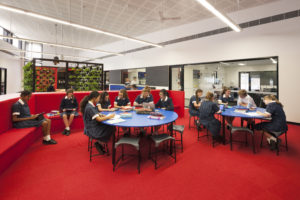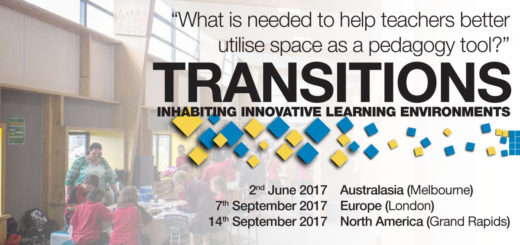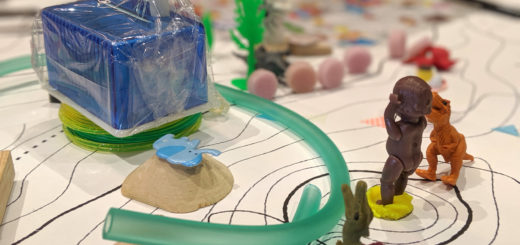Emerging teacher skills in ILEs: Adaptation and shifting practice

What teacher skills are needed in occupying ILEs?
In this guest post Scott Alterator discussed his research on the teacher skills needed in occupying innovative learning spaces.

The built environment can only be part of the story. Achieving teaching and learning that is student-oriented, agentic, authentic, creative and engaged with a range of technologies relies on the ongoing interaction between the learning program and the learning environment. Space is taken as necessary but not sufficient.
Teaching and learning programs capable of responding to the affordances of physical space and activating the desired learning for students are emerging across Australia. At the core of these successful programs is an elevation of the education program and a careful consideration of how space is conceptualised and used.
A brief interlude is necessary here. Understanding the learning program and environment as being in an interaction assumes that space is socially constructed. Spatiality (Boys, 2011; Lefebvre, 1994) elevates the role of the occupant; it is through the actions of agents that the space is understood. A final appreciation of the ILE necessarily considers both the space and its occupation. Consequently, the meaningful structures in an ILE are the learning programs that shape the behaviours of teachers and students.
My research in three ILEs in regional Victoria reveals particular skills emerging dependent on the degree of interaction between the ILE and the learning program. The degree of shift away from the traditional model of teaching shapes the skills required of the teachers. The table below briefly outlines the main features of the programs categorised by phases.
Teaching and Learning responses in phases
The emergent skills identified here are in line with the phases representing the distance between a traditional model generally articulated as industrial or teacher-centred.
| Early | Mid | Advanced |
| Collaborative skills – interpersonal skills, communication and cooperation. | Adaptability of practice within teams and various sized groups geared toward achieving student agency. | |
| Comfort with scrutiny and accountability. | Team orientation: preferencing goals of the team to those of self, adopting the sanctioned vision of teaching and learning. | |
| Flexibility of pedagogical beliefs and practice. | Reflexive practice: reflecting on individual and team practice (with specific goal of mutual agency). | |
Emergent skills in phases
Early phase skills are identified as preferable in any learning setting. In contrast to other settings, the ILEs elevated these skills to critical status, particularly in the area of collaboration and joint-practice. Without them, success was limited.
The mid to advanced phase skills are recognised as emergent. The conditions created by the advanced program resulted in skills considered to be amplified and different. This research narrows the focus on expertise toward adaptation. The ambiguity and uncertainty of occupying and responding to ILEs demands shift in daily routines and understandings of teaching and learning. The frequency and nature of interactions with colleagues and students means high level inter and intra-personal skills are essential. This collaborative work also means teachers need to understand their peers as resources to be used in service of student learning. Under these conditions this involves shared planning, synchronous teaching, shared reporting and accountability.
A complicating factor here is that minor adjustments to the program – team teaching without strategic alignment of other classes in the space – have revealed a negative impact on practice. As a result, existing traditions of practice are proving unsuitable in the ILE. The risk of not combining ILEs with a responsive learning program is very real.
Existing models of teacher standards in Australia do not offer the nuanced rendering of team-oriented reflexive practice emerging as central skills in ILEs. Further consideration must be given to teachers occupying ILEs, particularly where the affordances of space are leveraged toward programs producing up-scaled, student-oriented, agentic, and authentic learning.
For more information, see Scott’s presentation at Transitions Australasia 2017 here.
References
Boys, J. (2011). Towards creative learning spaces: Re-thinking the architecture of post-complusory education. London: Routledge.
Lefebvre, H. (1994/1974). The production of space (D. Nicholson-Smith, Trans.). Oxford: Blackwell.




The emergent skills identified in this post build a better understanding of what effective learning behaviours can look like in flexible learning space. From my research of one FLS, a significant challenge is supporting the late majority/resistant practitioners to engage with emergent skills at the ‘early phase’. From what I am learning, those who struggle to engage with flexible learning spaces need support (in line with challenge) through their journey of what is known, to what in their eyes, is unknown (or unproven?). The ‘simple’ matter of triggering a need flexibility in practice, collaboration and comfort with scrutiny is a significant challenge. As such, it is great to see quality research emerging in the ILE space which is being supported by equally well prepared professional learning support for staff.